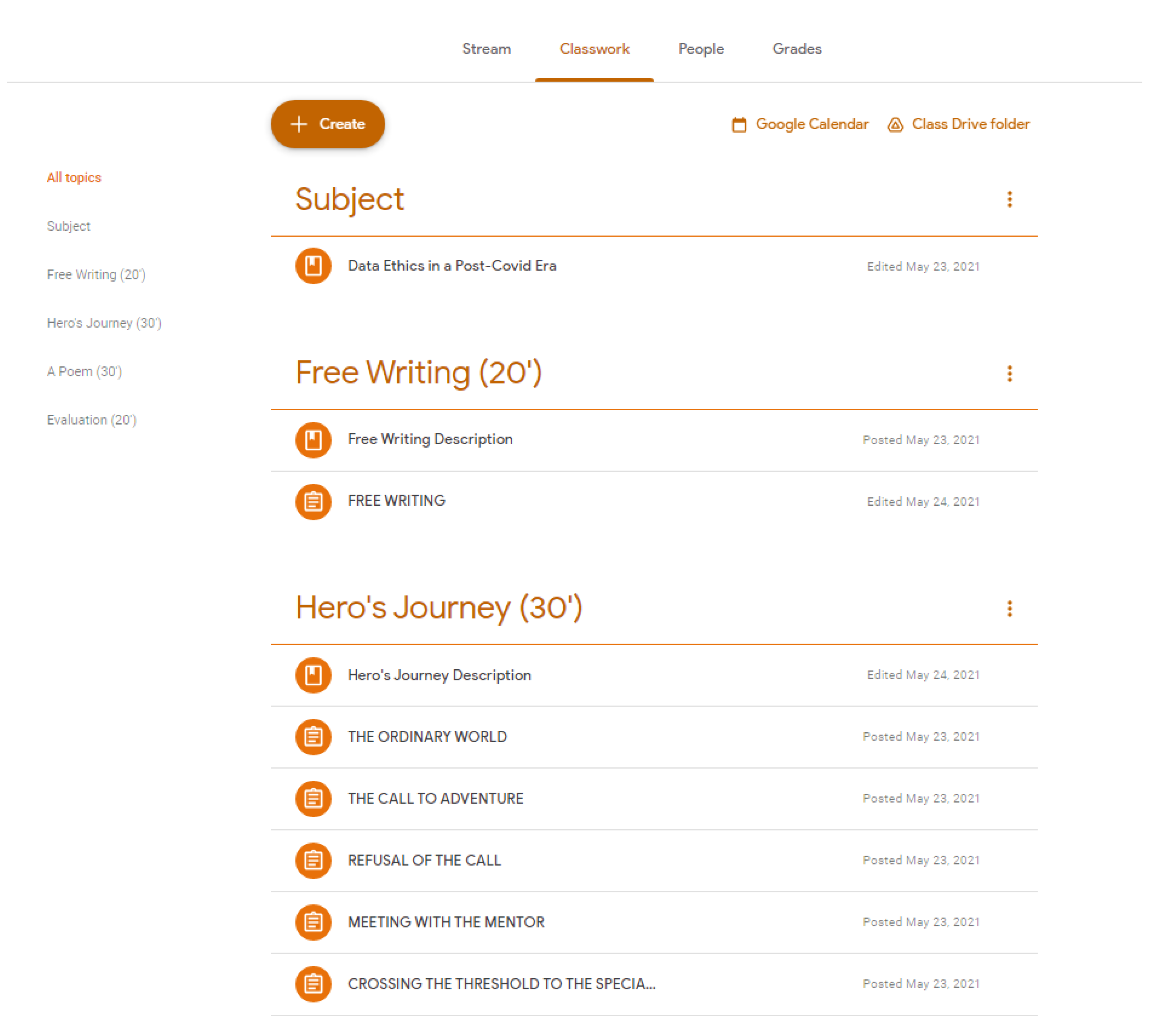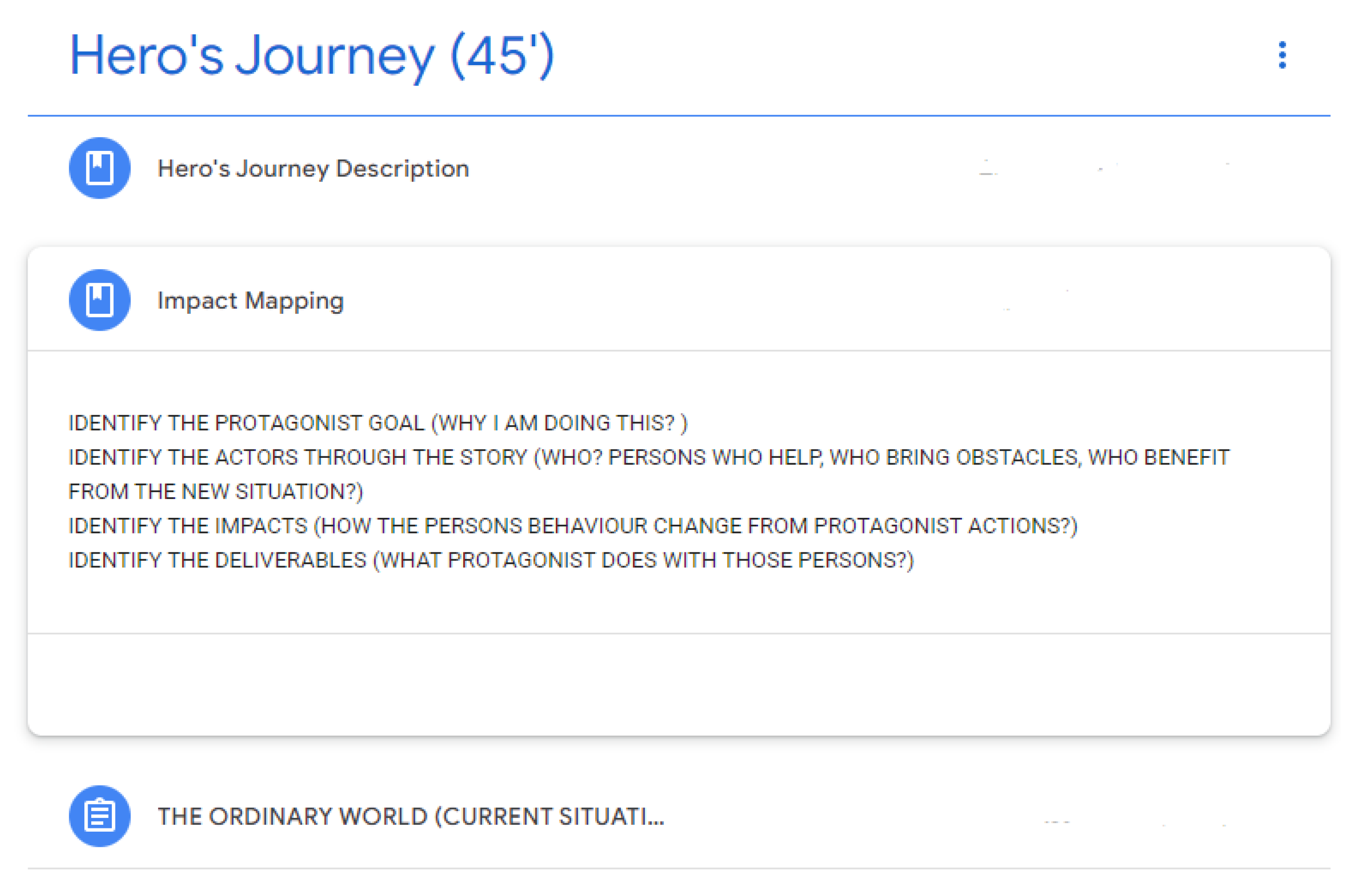Creative Narration as a Design Technique
Abstract
:1. Introduction
1.1. Current Situation
1.1.1. Creativity
- Orientation: clarify and identify the problem.
- Preparation: collect the relevant information.
- Analysis: analyze the collected data.
- Hypothesis: creation of alternative solutions.
- Incubation: pause and wait for new ideas.
- Synthesis: gather all the different pieces.
- Evaluation: test the results and new solutions and products.
1.1.2. Design Thinking
- Empathize: In this step, an empathetic understanding of the problem is attempted, usually through user research.
- Define: Here the data from the previous stage is synthesized to identify the core problems that are formulated into problem statements. In this step, persons can be utilized to keep the process human-centered.
- Ideate: In this step, ideas are generated, and brainstorming is a great tool for this end. The knowledge that emerged from the two previous phases opens the door for the designer to think out of the box and find new solutions to the problem.
- Prototype: This is the phase for experimentation by creating and testing the inexpensive implementation to investigate the ideas they have generated.
- Test: In this phase, the prototypes are tested. Although this is the final phase, the results are used to redefine and rework the previous phases. Design thinking is an iterative process.
1.2. Design Tools Categories
1.3. Scenario-Based Design
2. Materials and Methods
2.1. Workshops Teaching Tools
2.2. Creative Narration as an Ideation Technique
2.2.1. Scope
2.2.2. Creative Narration Technique
2.2.3. Ideation
2.2.4. Creative Narration: Rationale
2.3. Impact Mapping
- It is based on a method invented by an interaction design agency and similar to a team-building method, which means that it facilitates collaboration and interaction. It is significantly less bureaucratic and much easier to apply than many alternatives. It also facilitates the participation of groups of people from different backgrounds, including technical delivery experts and business users, helping organizations use the wisdom of crowds.
- It visualizes assumptions. Alternative models mostly do not communicate assumptions clearly. Impact mapping does, and because of that, it helps teams to make better decisions in rapidly changing environments, such as IT. The visual nature of this method also facilitates effective meetings and supports big-picture thinking, which provides organizational alignment.
- It is fast. It fits nicely with iterative delivery models that are now becoming mainstream in software.
2.4. First Workshop
2.4.1. Google Classrooms Description
2.4.2. Warm-Up Stage: Free Writing
2.4.3. Main Workshop Part: Hero’s Journey
2.4.4. Evaluation
- −
- The structured form of the workshop with small, well-defined and described steps.
- −
- The collaboration with other students.
- −
- That they were able to produce results in terms of ideation and scenario building.
- −
- They felt positive feelings when they followed the hero’s journey process because they were able to create a scenario. One mentioned that she would identify herself with the hero protagonist and thus tried to rescue the hero.
2.5. Second Workshop
2.5.1. Demographic Characteristics
2.5.2. Main Part
2.5.3. Keep notes and Focus Group
2.5.4. Products
2.5.5. Evaluation
3. Results and Discussion
3.1. First Workshop’s Results
3.2. Second Workshop’s Results
3.3. Discussion
4. Conclusions
Author Contributions
Funding
Institutional Review Board Statement
Informed Consent Statement
Data Availability Statement
Conflicts of Interest
References
- Kumar, V. 101 Design Methods: A Structured Approach for Driving Innovation in Your Organization; John Wiley & Sons: Hoboken, NJ, USA, 2012. [Google Scholar]
- Nyholm, J.; Langkilde, L. Et Benchmark Studie af Innovation og Innovationspolitik: Hvad Kan Danmark Lære? Inside Consulting: Reno, NV, USA, 2003. [Google Scholar]
- Sintoris, C.; Mavrommati, I.; Avouris, N.; Chatzigiannakis, I. Out of the box: Using gamification cards to teach ideation to engineering students. In Proceedings of the European Conference on Ambient Intelligence, Larnaca, Cyprus, 14 December 2018; pp. 221–226. [Google Scholar]
- Sawyer, R.K. Explaining Creativity: The Science of Human Innovation; Oxford University Press: Oxford, UK, 2011. [Google Scholar]
- Osborn, A. Applied Imagination-Principles and Procedures of Creative Writing; Read Books Ltd.: Reddich, England, 2012. [Google Scholar]
- Brown, T. Design thinking. Harv. Bus. Rev. 2008, 86, 84. [Google Scholar] [PubMed]
- Owen, C. Design thinking: Notes on its nature and use. Res. Q. 2007, 2, 16–27. [Google Scholar]
- Beckman, S.; Barry, M. Innovation as a learning process: Embedding design thinking. Calif. Manag. Rev. 2007, 50, 25–56. [Google Scholar] [CrossRef]
- Bratitsis, T. Storytelling digitalization as a design thinking process in an educational context. Moutsios Rentzos 2018, 21, 309–320. [Google Scholar]
- Maiden, N.; Jones, S.; Karlsen, K.; Neill, R.; Zachos, K.; Milne, A. Requirements engineering as creative problem solving: A research agenda for idea finding. In Proceedings of the 18th IEEE International Requirements Engineering Conference, Sydney, Australia, 27 September–1 October 2010; IEEE: Piscataway, NJ, USA; pp. 57–66. [Google Scholar]
- Osborn, A.F. Applied Imagination; Creative Education Foundation Press: Buffalo, NY, USA, 1953. [Google Scholar]
- Vaajakallio, K.; Mattelmäki, T. Design games in codesign: As a tool, a mindset and a structure. CoDesign 2014, 10, 63–77. [Google Scholar] [CrossRef]
- Mora, S.; Gianni, F.; Divitini, M. Tiles: A card-based ideation toolkit for the internet of things. In Proceedings of the 2017 Conference on Designing Interactive Systems, Edinburgh, UK, 10–14 June 2017; pp. 587–598. [Google Scholar]
- Carroll, J.M. Making Use: Scenario-Based Design of Human-Computer Interactions; MIT Press: Cambridge, MA, USA, 2000. [Google Scholar]
- Kim, M.; Lee, Y. Service storytelling: Exploring storytelling models in the context of the service design process. Adv. Intell. Syst. Comput. 2019, 790, 299–311. [Google Scholar]
- Quesenbery, W.; Brooks, K. Storytelling for User Experience: Crafting Stories for Better Design; Rosenfeld Media: New York, NY, USA, 2010. [Google Scholar]
- Propp, V. Morphology of the Folktale; University of Texas Press: Austin, TX, USA, 1968. [Google Scholar]
- Campbell, J. The Hero with a Thousand Faces; New World Library: Novato, CA, USA, 2008; Volume 17. [Google Scholar]
- Dam, F.R.; Siang, Y.T. Stage 3 in the Design Thinking Process: Ideate Copyright Terms and license. Available online: https://www.interaction-design.org/literature/article/stage-3-in-the-design-thinking-process-ideate (accessed on 14 June 2021).
- Girard, R.; Freccero, Y. Deceit, desire, and the novel. In The Novel: An Anthology of Criticism and Theory 1900–2000; John Wiley & Sons: Oxford, UK, 1965; pp. 294–314. [Google Scholar]
- Freytag, G. Freytag’s Technique of the Drama; Scott Foresman: Northbrook, IL, USA, 1984. [Google Scholar]
- Snævarr, S. Metaphors, Narratives, Emotions; Brill Publishers: Leiden, The Netherlands, 2018. [Google Scholar]
- Fletcher, A.; Benveniste, M. A new method for training creativity: Narrative as an alternative to divergent thinking. In Annals of the New York Academy of Sciences; Wiley Online Library: Hoboken, NJ, USA, 2022. [Google Scholar]
- Itonics-innovation.com. Trend Radar—Software for Trend Management. Available online: https://www.itonics-innovation.com/trend-radar (accessed on 14 June 2021).
- Morgan, D.L.; Krueger, R.A. The Focus Group Guidebook; Sage: Newbury Park, CA, USA, 1998. [Google Scholar]
- Wilkinson, S. Focus group methodology: A review. Int. J. Soc. Res. Methodol. 1998, 1, 181–203. [Google Scholar] [CrossRef]
- Brande, D. Becoming a Writer; Harcourt, Brace, and Company: New York, NY, USA, 1934. [Google Scholar]
- Elbow, P. Writing Without Teachers; Oxford University Press: Oxford, UK, 1973. [Google Scholar]
- Cameron, J.; Bryan, M. The Artist’s Way; Sounds True Recordings: Louisville, CO, USA, 1992. [Google Scholar]
- Vogler, C. The Writers Journey; Michael Wiese Productions: Los Angeles, CA, USA, 2007. [Google Scholar]
- Benedek, M.; Könen, T.; Neubauer, A.C. Associative abilities underlying creativity. Psychol. Aesthet. Creat. Arts 2012, 6, 273. [Google Scholar] [CrossRef]
- Brown, J.B. The use of focus groups in clinical research. In Doing Qualitative Research; Crabtree, B.F., Miller, W.L., Eds.; Sage Publications: Thousand Oaks, CA, USA, 1999. [Google Scholar]
- Shah, J.J.; Smith, S.M.; Vargas-Hernandez, N. Metrics for measuring ideation effectiveness. Des. Stud. 2003, 24, 111–134. [Google Scholar] [CrossRef]
























| Creative narration | They needed time to get familiar with the process but eventually, they enjoyed it and found it effective in terms of finding new products |
| Creative narration & Impact Mapping | They needed time to get familiar with the process and to find the subject of the story but eventually, they enjoyed it and found it effective in terms of finding new products. They skipped the impact mapping part. |
| Impact Mapping | Students did not follow the process and tried from the beginning to find the idea. |
Publisher’s Note: MDPI stays neutral with regard to jurisdictional claims in published maps and institutional affiliations. |
© 2022 by the authors. Licensee MDPI, Basel, Switzerland. This article is an open access article distributed under the terms and conditions of the Creative Commons Attribution (CC BY) license (https://creativecommons.org/licenses/by/4.0/).
Share and Cite
Manias, D.; Mavrommati, I. Creative Narration as a Design Technique. Information 2022, 13, 266. https://doi.org/10.3390/info13060266
Manias D, Mavrommati I. Creative Narration as a Design Technique. Information. 2022; 13(6):266. https://doi.org/10.3390/info13060266
Chicago/Turabian StyleManias, Dimosthenis, and Irene Mavrommati. 2022. "Creative Narration as a Design Technique" Information 13, no. 6: 266. https://doi.org/10.3390/info13060266
APA StyleManias, D., & Mavrommati, I. (2022). Creative Narration as a Design Technique. Information, 13(6), 266. https://doi.org/10.3390/info13060266





